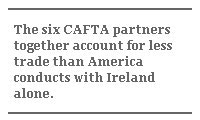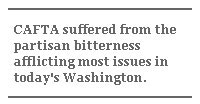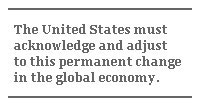CAFTA’s Close Call A Warning to US Policy Makers
CAFTA's Close Call A Warning to US Policy Makers

WASHINGTON: A free-trade agreement linking the US with the five Central American states and the Dominican Republic made it across the finish line in July – but just barely. Narrowly passing the Senate in early July, CAFTA then squeaked through the House by two votes. Even this small margin, the lowest for any modern American trade agreement, required a frenetic presidential lobbying campaign and a 47-minute vote.
Why the difficulty? To some extent, the CAFTA debate revealed tactical political mistakes that the Bush administration can avoid in the future. CAFTA also dealt with unusually protected commodities, notably sugar and textiles, which is inherently difficult. But the CAFTA debate also illuminates deeper anxieties about the global economy – anxieties that will reappear in the future. Left unaddressed, the political mistakes and generalized misgivings about US benefits from trade will make larger trade agreements, like the long-sought Free Trade Area of the Americas or the WTO's Doha Round, even more difficult than CAFTA.

CAFTA itself is a fairly small agreement for the United States. The six CAFTA partners together account for less trade than America conducts with Ireland alone. They also already enjoy substantial exemptions from US tariffs, meaning that CAFTA is building on an existing success story rather than creating something entirely new.
In 1989, Central America was at the heart of the US foreign policy debate. Wars in El Salvador, Guatemala, and Nicaragua had left 200,000 people dead and displaced nearly a million. Sixteen years later, all six CAFTA partners are at peace, and all are functioning – if sometimes imperfect – democracies. Guerrillas, death squads, and military aid are gone from the US Congressional agenda, replaced by relatively mundane arguments about sweater tariffs and sugar quotas.
Central America's success in the last decade reflects above all its own democratization and national reconciliation. But as former Costa Rican President Oscar Arias observes, it also owes something to an imaginative American trade policy known as the Caribbean Basin Initiative (CBI).

In 1985, the CBI gave the six CAFTA partners and their smaller island neighbors partial duty-free privileges. The six are exempt, for example, from tariffs of 32 percent on acrylic sweaters, 13.7 percent on cotton socks, and 20 percent on T-shirts. By the 1990s, the exemptions had allowed hundreds of clothing factories and several dozen textile mills to spring up around the region. They now employ over half a million Central American and Dominican workers, and support US$10 billion in annual exports. The US$3 billion in US imports from Honduras, up from US$450 million in 1989, accounts for as much as 20 percent of the Honduran economy.
The region's reliance on sales of bananas, oil, and coffee has dropped; its vulnerability to the ebb and flood tides of global commodity markets has dropped as well. Joined with US$8 billion in agricultural and technology exports (plus US$10 billion in remittances from the United States), the CBI helped create a healthier regional economy, and probably made reconciliation and democracy a little easier. CAFTA, making the CBI privileges permanent and broader, will build on this foundation.

The clothing business does raise questions of labor protection. Democratic opponents of the agreement were not wrong to raise them during the debate. And the agreement that finally passed, bolstered by tens of millions of dollars to support rural adjustment and labor law training and reform, was better because they did so. Altogether, it is a combination that should help the region, as it provides some new export opportunities for Americans in high-tech goods, textile fabric and services.
But its scale should not be overestimated. America's US$18 billion in imports from the six CAFTA partners combined seems like a lot, but is well below the US$27 billion in imports from Ireland. The US$3 billion in Honduran clothing, fruit, coffee, and other goods is the equivalent of about three days' worth of imports from Canada. CAFTA may bring the six countries together level with Ireland as an exporter to the United States. But it will not fundamentally change the US economy.
The agreement is certainly not a shock to America's economy – why, then, was the passage of CAFTA so difficult? Three different factors were at work.

First, CAFTA rubbed some sensitive spots. In America's generally open market, a few industries still get heavy protection. Clothes have tariffs ten times the American average, and sugar is among the world's most subsidized and protected farm products. The CAFTA countries provide one-eighth of US clothing and sugar imports, and policy change in such products is controversial. Some of the administration's earlier free-trade agreements, like those with Singapore and Chile, raised less opposition because they bypassed sensitive products. (Singapore exports mainly high-tech goods and services; Chile exports metals, fish, and winter fruit.) The big future initiatives won't. They will cover not only sugar and clothes, but other protected goods like cotton, dairy, and orange juice – and the administration needs to anticipate controversy.
Second, CAFTA suffered from the partisan bitterness afflicting most issues in today's Washington. Trade is a traditionally non-partisan field. But the Bush administration's confrontational approach to a long list of issues has shrunken the ground available for cooperation, and the US House leadership has intensified this many times over. It is no surprise that in such an atmosphere, the opposition party chooses mainly to oppose. With future agreements likely to be at least as difficult as CAFTA, the administration needs to shift its approach and begin working now with pro-trade Democrats.
Third, and perhaps most important, CAFTA crystallized public anxieties about major questions of trade, globalization, and the American economy. Since 2000, the perception of pressure from trade competition has grown rapidly. China has emerged as a center of world manufacturing and perhaps now of finance. The global telecommunications network has exposed more services industries to competition, with India's rise in this field well-publicized. Meanwhile, America's trade imbalances have grown as budget deficits rise and savings decline.
In this atmosphere, CAFTA became a proxy for debates much larger than the agreement itself about America's competitive standing in the world economy. Future trade debates will raise the same questions, and the base of public support for trade policy requires the administration to have more compelling answers.
Washington, as it proceeds with the next set of trade negotiations, must demonstrate a strong commitment to implementing existing agreements and develop active policies to reduce global trade imbalances by restoring control of government finances, raising domestic savings, and readjusting currency rates. Equally or more important is a recognition and clear statement to the public that China, and India too, have become genuinely more competitive as they open their economies and draw on global investment. Their success cannot simply be explained away as unfair trade. Instead, the United States must acknowledge and adjust to this permanent change in the global economy – through better education and restored commitment to scientific research.
The CAFTA debate is now in the past. But as Washington looks ahead to much larger initiatives at the WTO, in the western hemisphere and perhaps in Asia, the debate offers valuable lessons on the handling of American trade politics, and the need to complement trade policies with new initiatives in competitiveness and finance. The administration can pocket a narrow victory – or learn from it.
Edward Gresser is Director of the Progressive Policy Institute’s Project on Trade and Global Markets.